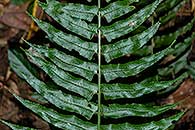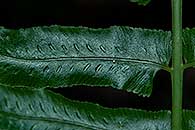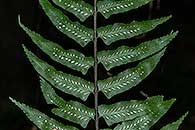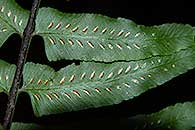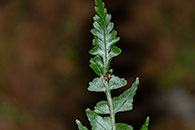Asplenium elliottii C.H. Wright
Synonyms |
Asplenium anisophyllum Kunze var. aequilateralis Hieron. |
|---|---|
Common name |
|
Description |
Rhizome erect, very rarely shortly creeping, to 8 mm diameter; rhizome scales concolorous, ovate in outline, 4–10 x 2.5–4 mm. Stipe straw-colored, 11–30(–80) cm long, thin, glabrous or with sparse scales to 4 mm long with widened base and occasionally with very thin side-lobes. Fronds tufted, proliferous. Lamina dark green, lanceolate in outline, 24–60(–100+) x 10–22 cm, pinnate, the lowermost pinnae slightly smaller, decrescent towards the apex, proliferous near apex.. Pinnae in 14–30 pairs, opposite or alternate, rhomboid or narrowly lanceolate in outline, (3–)5–16(–22) x (1.3–)1.6–3.3 cm, base truncate and parallel to rhachis on the acroscopic side, oblique on the basiscopic side, minutely toothed, apex gradually tapering to a sharp point; veins forked once; glabrous or occasionally with sparse scattered scales; petiolule 1–4 mm long. Rhachis slightly winged in the distal part, with sparse scales to 3.5 mm long with widened base and occasionally with very thin side-lobes. Sori many, from near costa to halfway towards the margin, brown or red-brown, linear to elliptic in outline, 3–4.5(–8) mm long; indusium pale, entire, 0.5–1(–1.3) mm wide. |
Notes | |
Derivation | elliotii: named after Charles Frederic Elliott (1847-1911), conservator of Forests in Kenya, who collected the type specimen in Kenya. |
Habitat | Moist montane forest, bamboo zone. |
Distribution worldwide | See African distribution. |
Distribution in Africa |
Burundi, Cameroon, Dem. Republic of Congo, Kenya, Rwanda, Tanzania , Uganda. |
Growth form |
Epiphytic, terrestrial. |
Literature |
|


